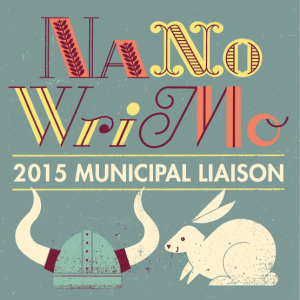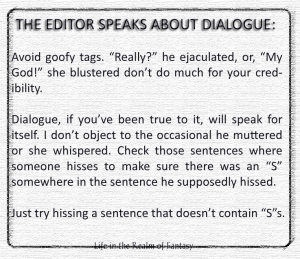 One thing we authors often do is forget to use contractions in dialogue. If you ever plan on publishing that manuscript, DON’T FALL INTO THAT TRAP!
One thing we authors often do is forget to use contractions in dialogue. If you ever plan on publishing that manuscript, DON’T FALL INTO THAT TRAP!
In some ways, this habit is fostered by participating in NaNoWriMo, National Novel Writing Month. The goal is to write a 50,000 word novel in 30 days. Word count is king, and new authors are sometimes advised not to use contractions to get the all-important word count of 1667 words per day.
I don’t recommend that to the Wrimos in my region because I want their manuscripts to be worth reading, and crawling through a manuscript and inserting contractions in the second and third draft are daunting tasks, even with a sharp-eyed editor helping to spot them.
Dialogue that is too formal is awkward and unnatural to the reader.
“I shall not be attending the party. I have a previous engagement to go whale-watching.”
That’s a whole lot of awkward.
While I might say something like that in a joking fashion to my sister or to a friend, in reality (and if I was writing dialogue) I would use contractions. I would also use what I personally think of as common phrasing. Fact–unless I work hard to change it, my written dialogue sounds like a Pacific Northwesterner, because that is who I am.
“Sorry, I can’t go to the party. I’m going whale-watching that day.”
When it comes to dialogue, your characters need to speak in expected ways. Remember, the reader’s eye is the “ear” through which they hear the dialogue. Nothing should stop the eye from moving on to the next sentence.
Feel free to break the rules of grammar if your character shows a blatant disregard for what’s correct. If on the first draft he wants to say, “I seen that movie last week. It were rubbish,” let him, at least on your first draft. You can tone it down on the second draft. This is a way to show you, the author, the description of your characters. On the second draft, have him say, “I seen it last week–it was rubbish.” It still gets the point across, but doesn’t stop the reader’s eye.
However, in regard to a main character, or a prominent secondary character, it’s usually best to avoid trying to convey accent by altering spelling. It’s difficult and tiresome to read an author’s attempt to convey a cockney or an Irish accent, so use colloquialisms and speech patterns instead.
Having said that, there are times when a slight accent is appropriate. If the character is making a MINOR appearance, using an accent and colloquialisms will give the reader feeling that they know that character, without resorting to an info dump.
 Fancy synonyms for ‘said’ are usually unnecessary and distracting. And remember, people do not smile, snort or smirk dialogue. In fact, it is often best to do away with dialogue tags altogether, once you have established who is speaking though the visual cues
Fancy synonyms for ‘said’ are usually unnecessary and distracting. And remember, people do not smile, snort or smirk dialogue. In fact, it is often best to do away with dialogue tags altogether, once you have established who is speaking though the visual cues
Sometimes, instead of using dialogue tags, miss a few “beats.” In script-writing, beats are little bits of physical action inserted into dialogue: John put the book down and looked out the window. Sarah turned and walked to the door. Used sparingly, they serve to punctuate the dialogue, to give the scene movement, and to maintain a strong mental picture in the absence of description. They are often best placed where there is a natural break in the dialogue, as they allow the reader to experience the same pause as the characters.
 Beats are an effective tool and are essential to good dialogue, but don’t overdo it. If your characters are fluttering their eyelashes, gazing into the distance or opening their laptops between every second line of conversation, the scene becomes about the action and not the dialogue, and the impact is diluted or lost entirely.
Beats are an effective tool and are essential to good dialogue, but don’t overdo it. If your characters are fluttering their eyelashes, gazing into the distance or opening their laptops between every second line of conversation, the scene becomes about the action and not the dialogue, and the impact is diluted or lost entirely.
And finally, don’t get too creative with dialogue tags. Stick to ‘John said.’ Unless you absolutely need a John screamed or a Elizabeth uttered or a Joan retorted (which you pretty much never do) just say it and let the reader’s imagination do the rest.









I agree with limiting speech tags, but make sure the reader doesn’t get confused if several pronouns appear in the dialogue, particularly if there are more than two characters in the scene.
LikeLike
@ Dave–maybe next week we will talk a bit more about talking (heh heh!)
LikeLike
Cheat Sheet Tip #35: The correct writing of the ellipsis is with spaces between the periods. MS Word will try to “correct” that to a single line of three periods which count as one word. With spaces, you get 3 words . . . at least, compared to…this way.
Cheat Sheet Tip #36: Writing the Em dash may cause the word count to be reduced by connecting both words as one. Try spaces before – and after – any dash. If you don;t like it, you can scrunch them together again in December.
LikeLike
@Stephen–True–and not as difficult to find as if they were stilted dialogue. I still encourage new wrimos to try to avoid things they’ll have to clean up later, speaking as a friend who wants to see them succeed.
LikeLike
Perfect timing! I was just running into this last night as I was typing a long section of dialogue. Thank you!
LikeLike
Perfect timing! I just ran into this last night as I was typing a long section of dialogue. I find speaking dialogue out loud helps me a lot, but it’s definitely less formal than I would imagine writing it at first.
Here is a thought- I often see a scene in my head as a picture, like it’s playing out as a movie. Then I try to describe all of that scene in words. I really do wonder if that makes it too laborious to a reader?
Thanks!
LikeLike
@Girlagainsttheworld–no, that’s not too laborious at all. Actually that works well for our visually-minded writers in today’s world. I give a seminar on writing dialogue, where I use the opening scene of the”The Matrix”, the interaction between Neo and Choi and the computer as one of the examples of ways to visualize natural-sounding dialogue.
LikeLike
Lots of good advice here. As for the dialogue, I’d say think even terser if you want it to sound like real speech (often the subject pronoun, especially when it’s “I,” can be dropped).
LikeLike
@Scott–I hadn’t thought of it that way but you’re right. That’s how we talk. In some work that might be effective, especially if it’s set in a modern context.
LikeLike